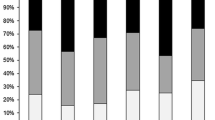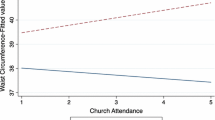Abstract
Obesity and obesity-related morbidity and mortality are an ongoing concern in developed countries. Religion is associated with reduced premature mortality and morbidity. However, the association between religion and obesity is unclear and unexplored in the general English population. This cross-sectional study uses Health Survey for England 2012 data to investigate the association of religious affiliation and BMI. A representative sample of 7,414 adults (16 years or older) was included. Waist-to-hip ratio was measured in a smaller sample and was explored as a secondary outcome. Interviews were administered, questionnaires self-completed, and height and weight measured. Sequential linear regression models were used to adjust for health behaviours. Religious affiliation was associated with a 0.91 kg/m2 higher BMI. Some of this was explained demographically, but it was not accounted for by smoking status, alcohol consumption or physical activity level. Evidence of this association was strongest among those affiliated to a Christian religion. A significantly higher WHR was also seen in Christian and Sikh men. English prospective studies measuring intrinsic religiosity and dietary energy are needed. Religious communities may need greater healthy weight promotion or benefit from tailored interventions built on their beliefs.







Similar content being viewed by others
References
Breslow, R. A., & Smothers, B. A. (2005). Drinking patterns and Body Mass Index in never smokers: National Health Interview Survey, 1997–2001. American Journal of Epidemiology, 161(4), 368–376.
Cline, K. M. C., & Ferraro, K. F. (2006). Does religion increase the prevalence and incidence of obesity in adulthood? Journal for the Scientific Study of Religion, 45, 269–281. doi:10.1111/j.1468-5906.2006.00305.x.
Colditz, G. A., Giovannucci, E., Rimm, E. B., Stampfer, M. J., Rosner, B., Speizer, F. E., et al. (1991). Alcohol intake in relation to diet and obesity in women and men. American Journal of Clinical Nutrition, 54(1), 49–55.
Craig, R., & Mindell, J. (Eds.). (2012). Health Survey for England 2012: Methods and documentation (Vol. 2). Leeds: The Health and Social Care Information Centre.
Djuric, Z., Mirasolo, J., Kimbrough, L., Brown, D. R., Heilbrun, L. K., Canar, L., et al. (2009). A pilot trial of spirituality counselling for weight loss maintenance in African American breast cancer survivors. Journal of National Medical Association, 101(6), 552–564.
Duro, O. K., Sarkisin, C. A., Leng, M., & Mangione, C. M. (2010). Sisters in Motion: A randomised controlled trial of a faith based physical activity intervention. Journal of the American Geriatricians Society., 58(10), 1863–1869.
Filozof, C., Pinilla, F., & Fernández-Cruz, A. (2004). Smoking cessation and weight gain. Obesity Reviews, 5(2), 95–103.
Gillum, R. F. (2006). Frequency of attendance at religious services, overweight, and obesity in American women and men: The Third National Health and Nutrition Examination Survey. Annals of Epidemiology, 16(9), 655–660. doi:10.1016/j.annepidem.2005.11.002.
Health Survey for England-2011 (2012) Health, social care and lifestyles, Adult Anthropometric Measures, Overweight And Obesity, vol 1 Chap. 10.
Hellerstedt, W. I., Jeffery, R. W., & Murray, D. M. (1990). The association between alcohol intake and adiposity in the general population. American Journal of Epidemiology, 132(4), 594–611.
Hoge, R. (1972). A validated intrinsic religious motivation scale. Journal for the Scientific Study of Religion, 11(4), 369-376. Article Stable URL: http://www.jstor.org/stable/1384677.
Kim, K. H., Sobal, J., & Wethington, E. (2003). Religion and body weight. International Journal of Obesity, 27, 469–477. doi:10.1038/sj.ijo.0802220.
Klesges, R. C., Meyers, A. W., Klesges, L. M., & LaVasque, M. E. (1989). Smoking, body weight, and their effects on smoking behavior: a comprehensive review of the literature. Psychological Bulletin, 106(2), 204.
Koenig, H., King, D., & Carson, V. B. (2012). Handbook of religion and health (2nd ed.). USA: Oxford University Press.
Kortt, M.A., & Dollery, B.A. (2012). Religion and BMI in Australia. Journal of Religion and Health, Published online 1 June 2012. http://dx.doi.org/10.1007/s10943-012-9621-x.
Lancaster, K. J., Carter-Edwards, L., Grilo, S., Shen, C., & Schoenthaler, A. M. (2014). Obesity interventions in African American faith-based organizations: a systematic review. Obesity Reviews, 15(S4), 159–176.
Luppino, F. S., de Wit, L. M., Bouvy, P. F., Stijnen, T., Cuijpers, P., Penninx, B. W. J. H., & Zitman, F. G. (2010). Overweight, obesity, and depression: A systematic review and meta-analysis of longitudinal studies. Archives of General Psychiatry, 67, 220–229.
Lycett, D.A. (2012). Weight gain associated with smoking cessation: A cohort analysis and feasibility trial for dietary management (Doctoral dissertation, University of Birmingham).
Lycett, D., Munafò, M., Johnstone, E., Murphy, M., & Aveyard, P. (2011). Associations between weight change over 8 years and baseline body mass index in a cohort of continuing and quitting smokers. Addiction., 106(1), 188–196. doi:10.1111/j.1360-443.2010.03136.x.
Mannisto, S., Pietinen, P., Haukka, J., Ovaskainen, M. L., Albanes, D., & Virtamo, J. (1996). Reported alcohol intake, diet and body mass intake in male smokers. Eurpoean Journal of Clinical Nutrition., 50, 239–245.
Miyata, G., Meguid, M. M., Varma, M., Fetissov, S. O., & Kim, H. J. (2001). Nicotine alters the usual reciprocity between meal size and meal number in female rat. Physiology & Behavior, 74(1), 169–176.
NatCen Social Research and University College London. Department of Epidemiology and Public Health, Health Survey for England, 2012 [computer file]. Colchester, Essex: UK Data Archive [distributor], April 2014. SN: 7480, http://dx.doi.org/10.5255/UKDA-SN-7480-1.
Parker, V. G., Coles, C., Logan, B. N., & Davis, L. (2010). The LIFE project: A community based weight loss intervention program for rural African-American women. Family Community Health, 33(2), 133–143.
Reicks, M., Mills, J., & Henry, H. (2004). Qualitative study of spirituality in weight loss programmes: Contribution to self efficacy and locus of control. Journal of nutrition education and behavior, 36(1), 13–15.
Ronel, N., & Libman, G. (2003). Eating disorders and recovery: Lessons from overeaters anonymous. Clinical Social Work Journal, 31(2), 155–171.
The Surgeon General (US). (2001) The surgeon general’s call to action to prevent and decrease overweight and obesity. Office of the surgeon general; Office of disease prevention and health promotion; Centers for disease control and prevention; National Institutes of Health (US). Rockville (MD).
Tolstrup, J. S., Halkjaer, J., Heitmann, B. L., Tjonneland, A. M., Overvad, K., Sorensen, T. I. A., & Gronbaek, M. N. (2008). Alcohol drinking frequency in relation to changes in waist circumference. American Journal Clinical Nutrition, 87(4), 957–962.
Tolstrup, J. S., Heitmann, B. L., Tjonneland, A. M., Overvad, O. K., Sorensen, T. I. A., & Gronbaek, M. N. (2005). The relation between drinking pattern and body mass index and waist and hip circumference. International Journal of Obesity, 29, 490–497.
Author information
Authors and Affiliations
Corresponding author
Rights and permissions
About this article
Cite this article
Lycett, D. The Association of Religious Affiliation and Body Mass Index (BMI): An Analysis from the Health Survey for England. J Relig Health 54, 2249–2267 (2015). https://doi.org/10.1007/s10943-014-9975-3
Published:
Issue Date:
DOI: https://doi.org/10.1007/s10943-014-9975-3




